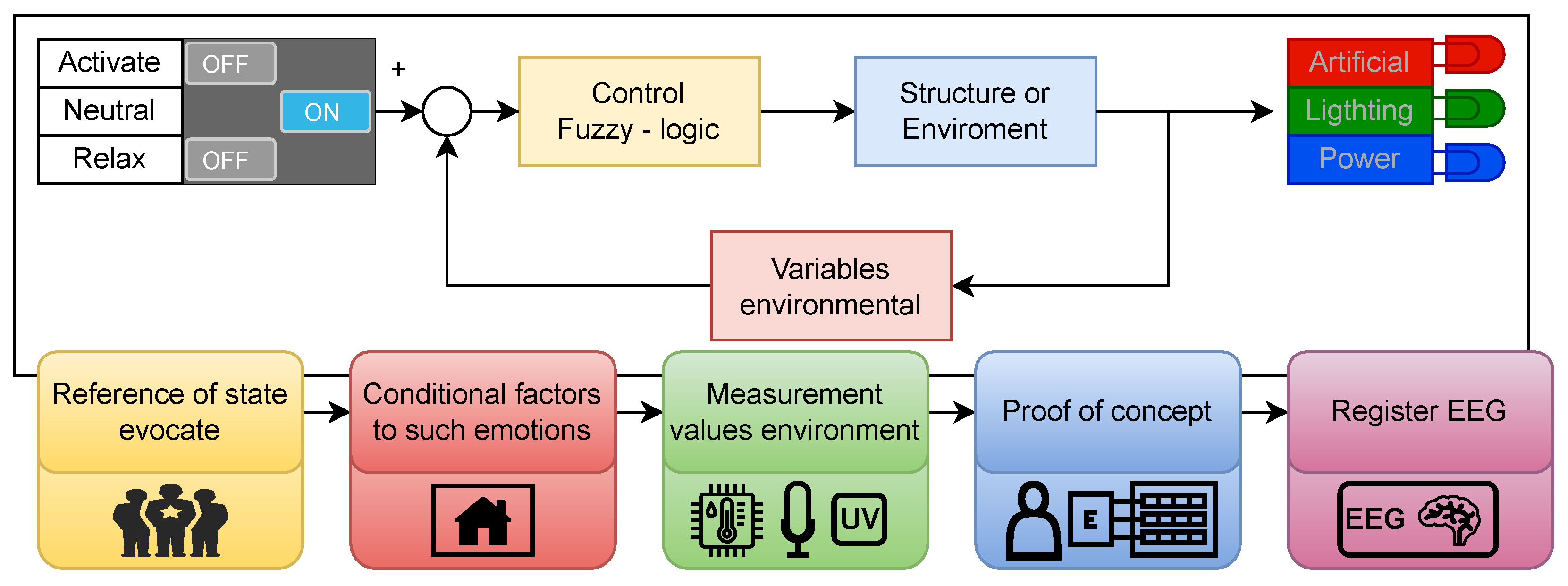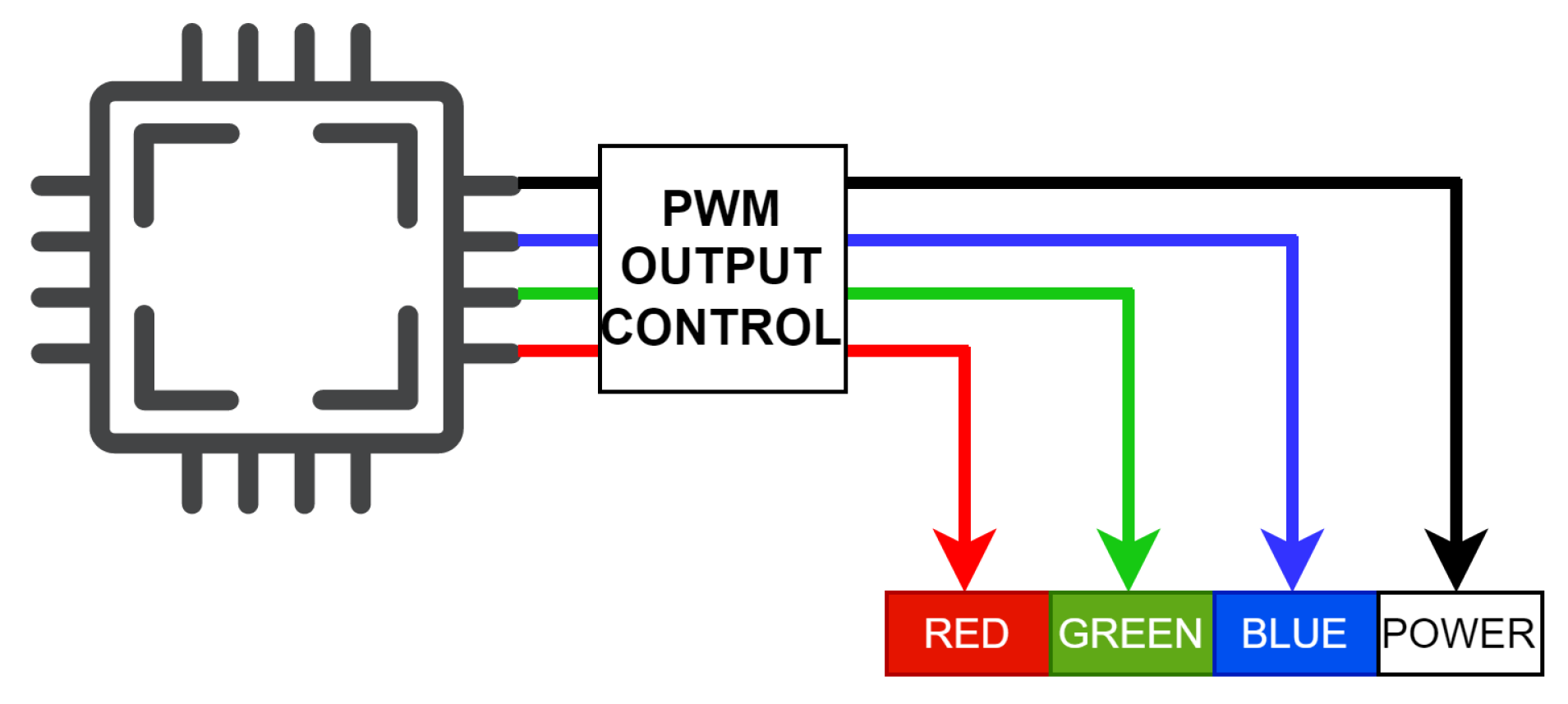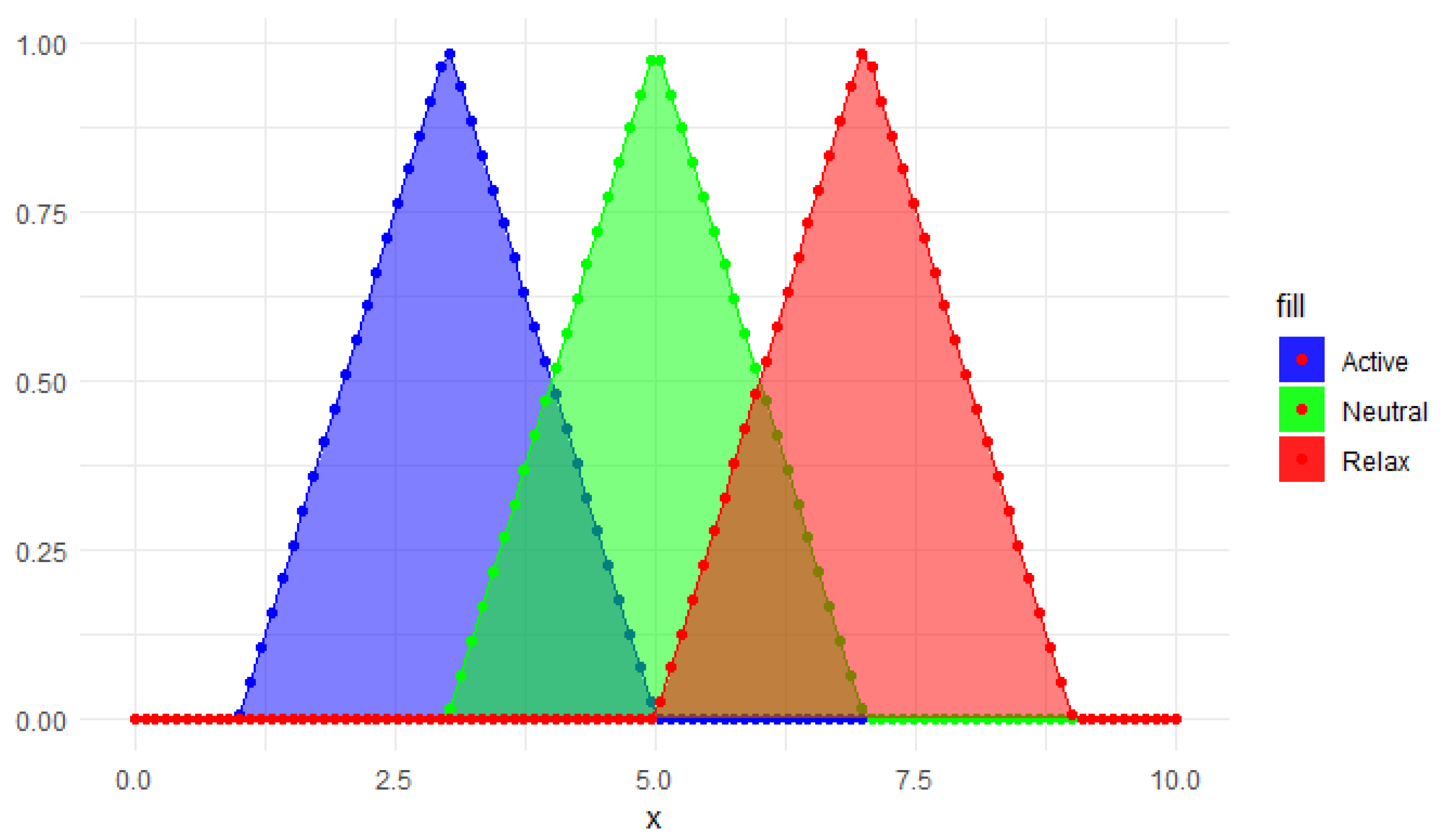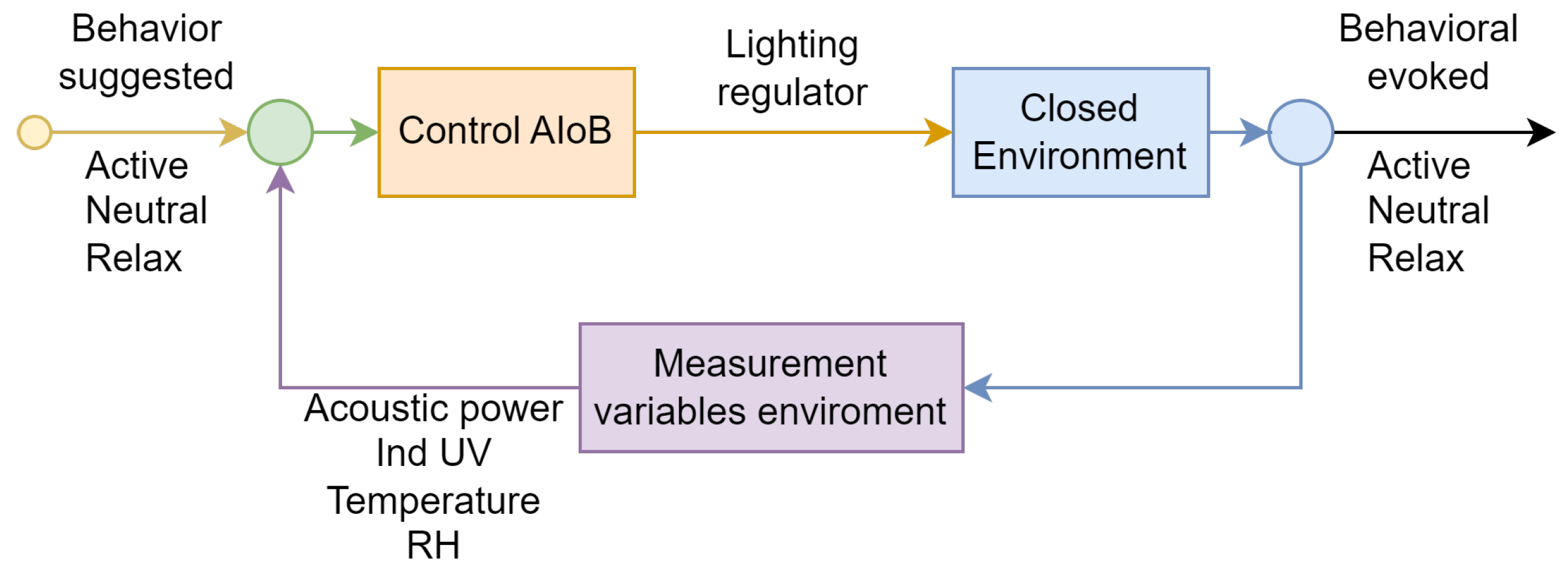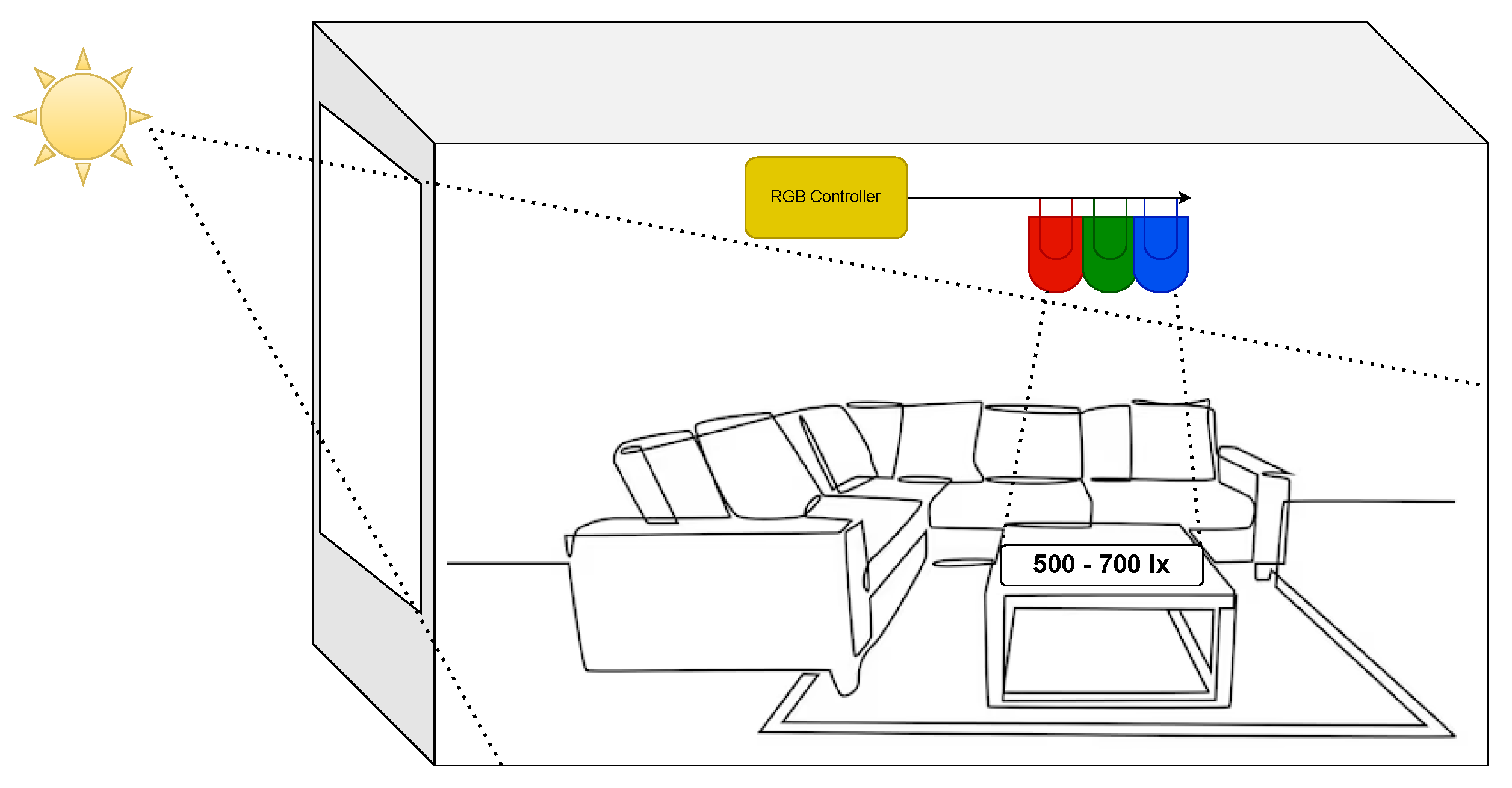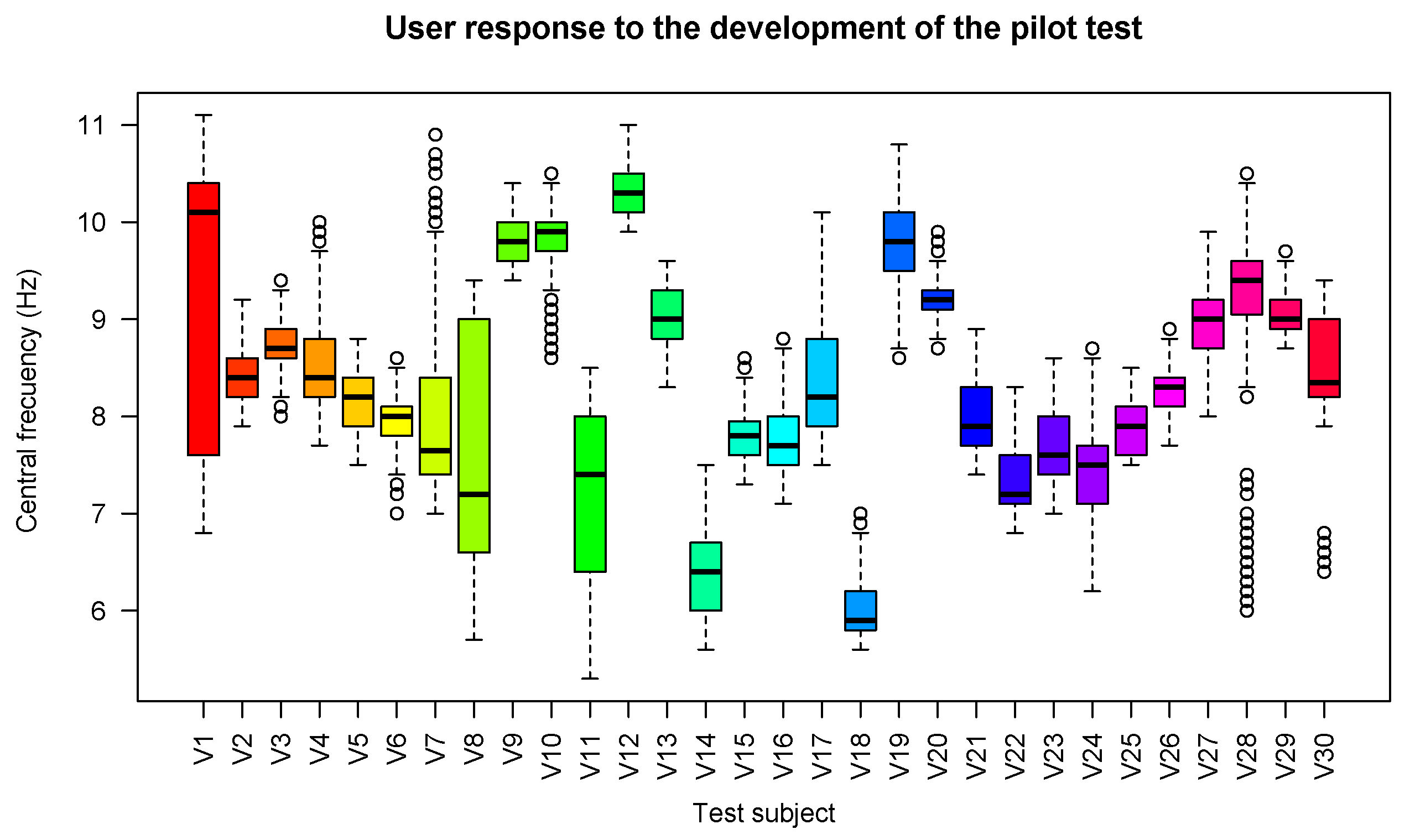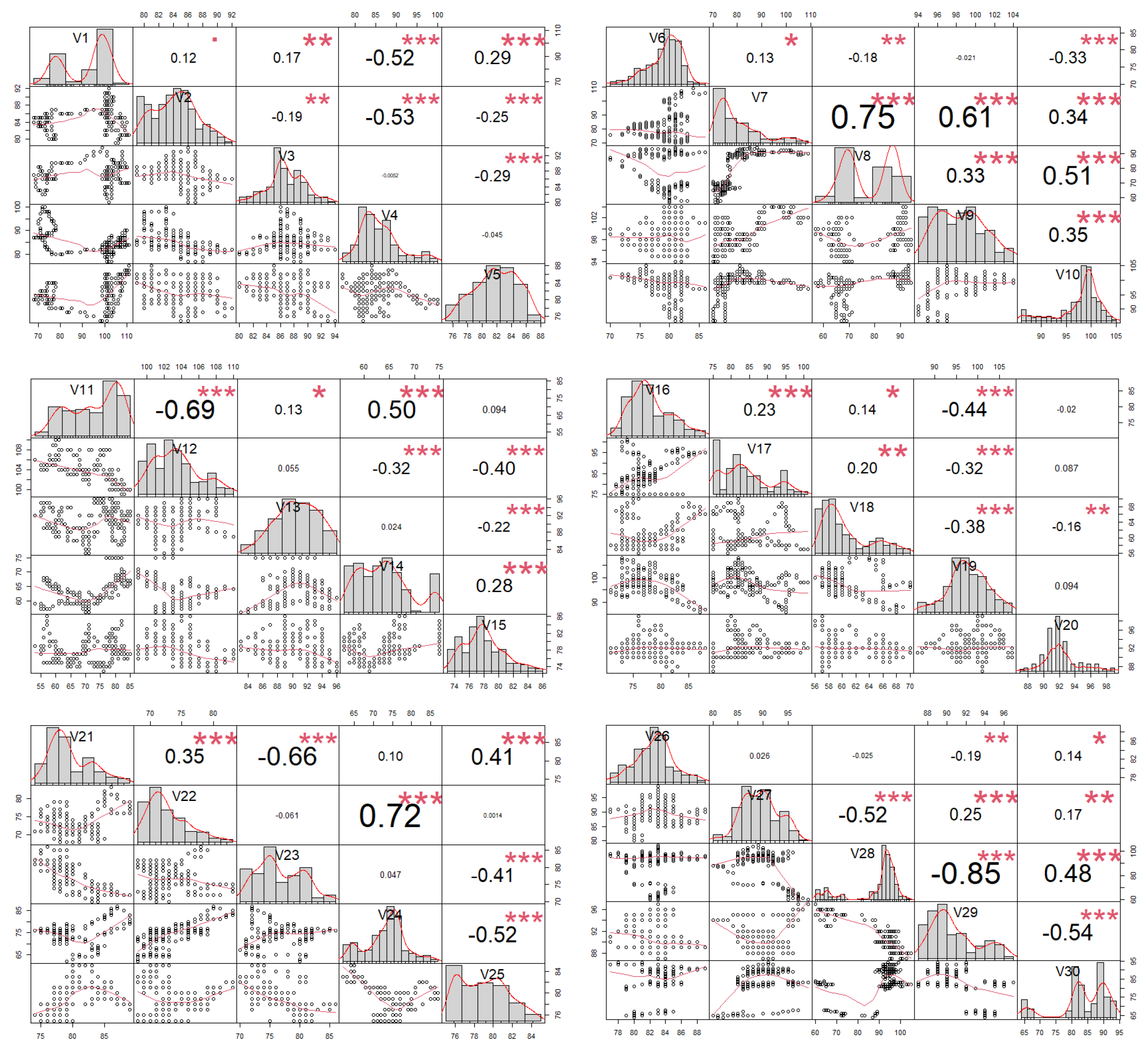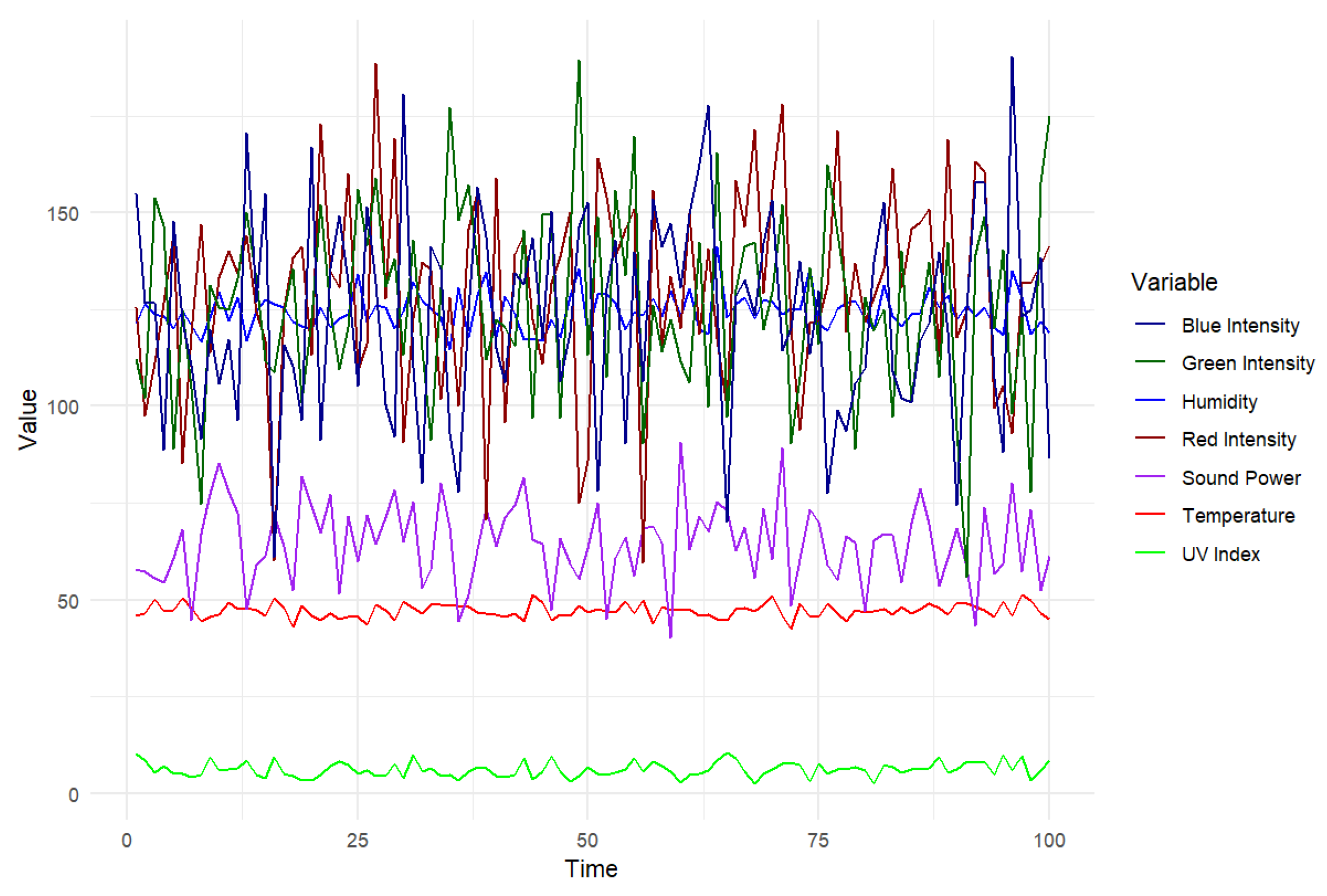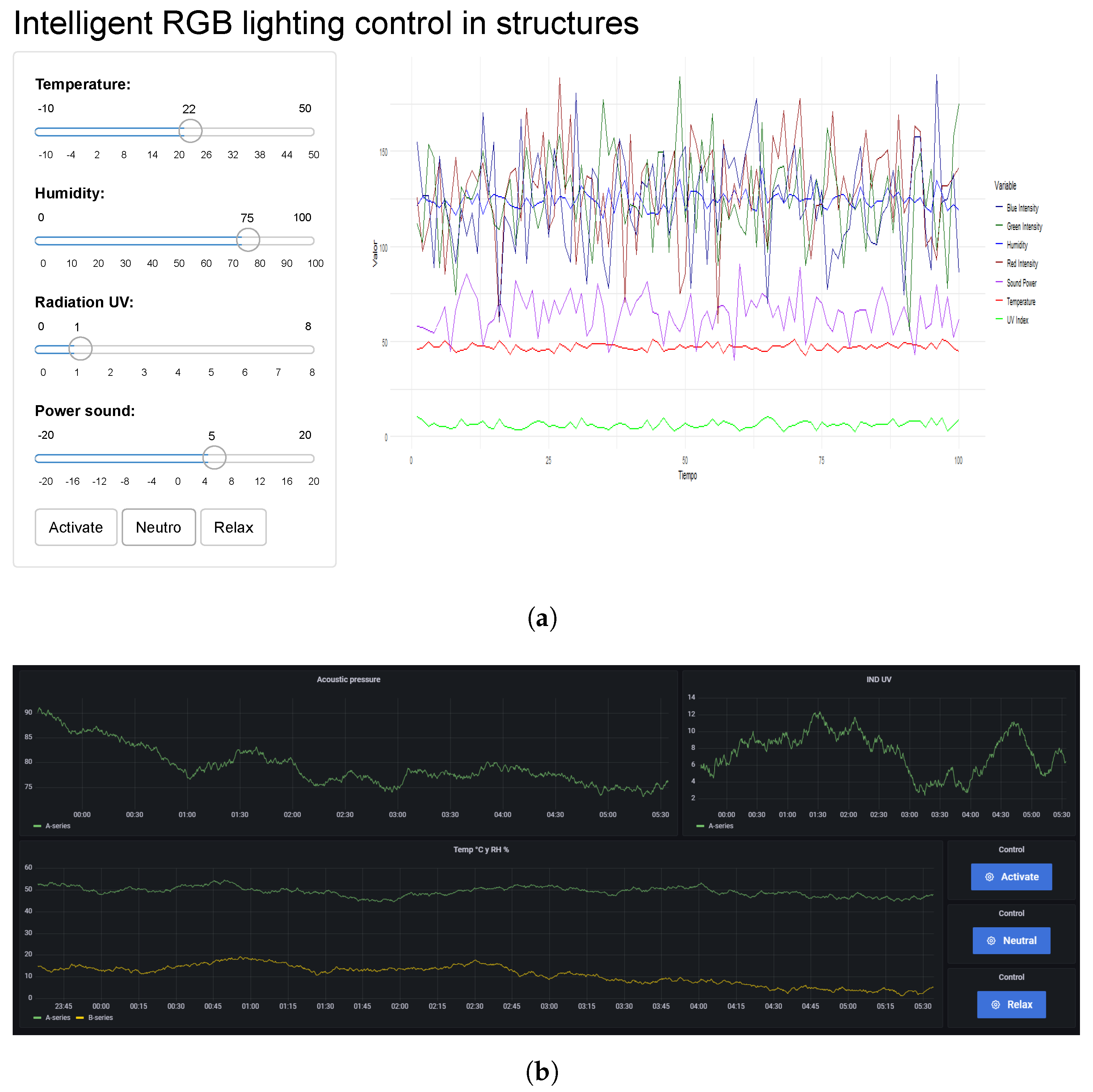1. Introduction
Artificial lighting can have a strong influence on people’s emotions and behavior. Inadequate lighting exacerbates fatigue or may trigger aggressive responses in people. Contrary to common belief, adequate lighting does more than just illuminate a space; it enhances the sense of well-being among individuals, boosts concentration, and fosters productivity. In the research the design of lighting indicates that LED lighting with a correlated color temperature (CCT) and an illuminance level can significantly improve visual comfort [
1]. It has also been observed to provide good visual comfort and task performance, suggesting that fine-tuning the CCT and illuminance of LED lighting can lead to improvements in work efficiency and satisfaction.
A smart RGB lighting control system adjusts lights to create the appropriate environment at any given moment. The system operates automatically, with three possible states as reference: activate, tranquilize, or neutral. If the environment manager does not specify an intention state, the system initializes with a neutral condition.
The relevance of natural light is not only for energy efficiency, but also for psychophysical comfort and emotional connection with the environment [
2]. Other studies like the strategic placement and monitoring of sensors are crucial for maximizing energy savings and ensuring the optimal performance of lighting systems in office environments [
3].
This system utilizes the measurement of environmental variables with a holistic and integrated approach combined with a neuro-fuzzy controller that smoothly adjusts lighting transitions. The research begins with identifying environmental variables affecting behavior and selecting suitable sensors using AIoT (Artificial Intelligence of Things) systems.
Proper control of artificial lighting within a structure contributes to the well-being and productivity of people within. Different regions around the world have regulated indoor lighting. In Europe, the UNE 12464-1 standard [
4] establishes parameters for lighting flux to meet three objectives: visual comfort, visual performance, and safety.
The UNE-EN 12464-1 standard [
4] is a European regulation that establishes the requirements and recommendations for the lighting of indoor spaces. This standard provides clear and objective guidelines on the minimum levels of illumination, light uniformity, color rendering, correlated color temperature (CCT), and other parameters necessary for electric lighting to meet visual task comfort and performance.
The standard takes into account the Unified Glare Rating (UGR), the luminous level (Lux), and the color rendering (Ra). As for the CCT, the standard does not specify an exact value, but generally recommends a CCT that is appropriate for the type of activity and the conditions of the indoor space.
As for the illuminance (lx), the standard specifies different minimum illuminance levels for different types of tasks and workspaces. For example, for common visual tasks such as reading and writing in offices, the standard specifies a minimum illuminance of 500 lx.
Despite this regulation, lighting has a component that directly affects people: color temperature [
5]. This is determined from the radiation principle of a black body and can be categorized into two variations: cold light (blue light), which occurs within the 10,000 °K range; and warm light (red light), which occurs from 1000 °K [
6,
7].
In this research proposal, artificial lighting serves as the control element. Within this context, research shows that lighting has such a strong power that it synchronizes the biological clock, indicating when we should prepare for daily tasks and when to take a break and sleep [
8]. Its action also adjusts our emotions, which is why sunny days are considered happy days and stormy days are assumed to be sad [
9]. In the field of artificial lighting, we can make this analogy and envision a control system that allows us to identify environmental conditions and suggest assistance to the emotional state of people within a space.
The effects of the lack of artificial light on the human body required a complex study that, in 2001, led to the discovery of additional light receptors, i.e., cells sensitive to artificial light [
10]. The body has these receptors that send signals to the brain, regulating the day/night rhythm. This is what we call “circadian rhythm”, and using artificial light appropriately, we can adapt and enhance this cycle. These receptors trigger a biological effect by producing two hormones: melatonin, responsible for sleep, and dopamine, responsible for activity. These hormones influence blood pressure, vitality, heart rate, and mood, among others [
11,
12,
13].
Effective control of artificial lighting can impact individuals by considering not only the visual effect but also the biological aspects, the environmental conditions and the feeling triggered, enhancing the effectiveness of stimuli [
14]. Well-lit indoor environments directly influence behavior, as neurology studies have proven that light directly affects mood and enhances emotions [
15,
16].
In the field of artificial lighting, we can make this analogy and envision a control system that allows us to identify environmental conditions and suggest assistance to the emotional state of individuals within a space [
17]. Visual stimulation of the retina generates information flow through the optic nerve to the thalamus, where visual cells process the information and transmit it to the visual cortex. Further information processing occurs in the visual cortex, generating responses measured in response time through LPT [
13].
Artificial lighting systems have a direct impact on our emotions and can influence how we feel. Through their color, intensity, or color temperature, light can affect mood [
8]. The measurement of chromatic lightings is conducted in degrees Kelvin, although it does not directly correspond to temperature.
The color value is determined as the temperature at which an ideal black body must be heated to emit a specific color. Hence, references to degrees Kelvin are used as a variable associated with color. Colors tending toward red (2.000 °K) have an energizing effect, while those with a blue tone (10.000 °K) induce a calming effect, and amber or white light (natural light at 6.000 °K [
18]) maintains the current mood. The
Figure 1 illustrates the temperature–color relationship and the resulting thermal sensation conveyed [
19].
The direct relationship between the human body and lighting is known as the circadian rhythm. This rhythm can influence important bodily functions such as hormone release, eating habits, digestion, and body temperature.
It changes with natural lighting conditions and affects the perception of attention or sleep depending on the stimulus and lighting color temperature. Previous research studies have proven that changes in the circadian cycle directly affect people’s behavior and, therefore, mental health [
7].
Beyond lighting, environmental factors like temperature, humidity, UV radiation, and acoustic pressure influence our comfort levels within certain indoor structures. The inherent nature of a structure implies a certain level of impact; for instance, governmental facilities, hospitals, transportation hubs, or bustling structures often create stressful environments. This may result in subtle triggers affecting individual and/or group behavior, leading to chaotic situations.
Late positive potential (LPP) is a neural response associated with emotional attention. It has been observed that this potential is modulated as a response to emotional stimuli, and controlled environments can influence LPP as well [
20].
Maintaining suitable conditions within indoor structures contributes to shaping emotions [
21]. When within a structure, regulating conditions influences behavioral intentions. For instance, in high temperatures, people may choose between opening windows to cool down or keeping them shut to block out external noise [
22].
This comprehensive approach aims to establish a system leveraging artificial light as a behavioral regulatory parameter. hlIt has a functional role in terms of adhering to luminous Lux (lx) requirements and also specifies lighting temperature requirements to create suitable stimuli for the environment’s or structure’s programmed intention [
21].
Despite various regulations and standardizations concerning artificial lighting, limitations persist mainly in terms of functionality and luminous (lx). For instance, hlthe UNE 12464-1 [
4] standard notes specific limitations across different structures.
In certain specific cases, such as healthcare facilities or art schools, the standard sets lighting that facilitates color identification, requiring color temperature radiation > 6000 °K. In other structures, glare phenomena may lead to risk situations, such as when entering or exiting a car tunnel, where rapidly changing lighting conditions can affect drivers’ visual capabilities [
23].
In educational structures, excessive or defective lighting levels could create environments unsuitable for reading or writing. Cold lighting may also enhance the feeling of being outdoors, thereby allowing for longer exposure times indoors. Conversely, warm light fosters a calmer environment and promotes social positivity [
24].
For these reasons, the research addresses the potential of artificial lighting within several structures and indoor environments as a comprehensive system that enhances the well-being of individuals within. The developed system has the capability to measure environmental conditions such as temperature, relative humidity, UV radiation, and acoustic pressure within an enclosed structure or environment [
23].
This measurement aligns with the intended atmosphere of the environment, which may be activating, relaxing, or neutral. Based on the measured values and the intention, the system, equipped with neuro-fuzzy control, adaptively creates a response of artificial lighting in terms of both radiated power and color temperature.
The overarching workflow diagram in the
Figure 2 delineates how the system unfolds the control process as a closed-loop system. Furthermore, the diagram exhibits the flow of research development, encompassing each step to solidify the design.
This enables the system to generate light stimuli conducive to functionality and positive behavior. By considering in the influence of other environmental variables, the system ensures energy efficiency and aids in preventing overstimulation.
The research has led to several contributions:
Development of an AIoT Lighting System: An innovative RGB lighting control system based on AIoT technology is introduced. Acting as an invisible master of ceremonies, this system dynamically adjusts lights to create favorable environments and enhance spatial perception.
Integration of weather sensors: The proposed system integrates with weather sensors to adapt lighting to changing environmental conditions. This approach reflects a profound understanding of the correlation between climate and lighting preferences, thus enabling personalized environments.
Neuro-fuzzy control for customization: A novel approach is introduced using neuro-fuzzy control to correlate environmental variables with artificial lighting conditions. This allows for precise and adaptive adjustments in response to changes in human emotions, fostering friendly and swiftly adaptable environments.
Application in social and enclosed structures and environments: The system is tailored for structures of diverse nature, serving as a visual stimulus to contribute to intended emotional states in the target audience. This practical application suggests the versatility and adaptability of the system in structures such as offices, homes, or public spaces.
Energy efficiency and sustainability: Highlights the system’s capacity to reduce energy consumption through efficient lighting implementation. This contribution not only prioritizes emotional well-being but also emphasizes environmental sustainability and resource optimization.
This holds significance as it has been proved that 90% of the time when natural light is available individuals in Western societies tend to stay indoors, be it in academic, work, or recreational environments.
The system hypotheses are implemented via fuzzy rules and the system is validated through a pilot test. A concept test is conducted, demonstrating the system’s real capacity, with significant outcomes. Among these, an average frequency of 9.8 Hz during the test indicates a calm state, supporting the hypothesis that adaptive lighting positively influences emotions.
This paper provides a comprehensive description of the construction of the instrumentation system, enabling other researchers to replicate and expand upon this approach. Moreover, this study serves as a conduit for comprehending and implementing the proposed AIoT technology in scenarios where devices can extend beyond merely illuminating a space.
With a neuro-fuzzy system that adjusts automatically based on collected information, the system can be placed in different social contexts, irrespective of language or cultural barriers. This is achieved due to the system adaptability using AI to fine-tune controller parameters.
The research is anchored in the objective of enhancing the control capabilities of a system for turning artificial lighting on and off within a structure. While the system is based on maintaining levels based on CCT values, this implies a limitation in the approach susceptible to errors, it enables the use of other approaches in future research. This system aims to create structures with a “sense”, to generate stimuli in accordance with intention, thereby requiring each component of the system to be self-contained and operate independently. However, this architecture implies system compatibility with different elements of the AIoT concept as part of a broader technological ecosystem.
The remainder of this paper is structured as follows: First, relevant previous research informing the research approach is presented. Then, the foundational concepts underpinning the proposal are introduced. Second, the system’s design and features will be discussed. Third, the development parameters used, the implementation, and the tests conducted will be discussed. Fourth, the experiences and some results will be explained, and finally, the system’s capacity in the proposed context will be concluded.
2. Related Work
The system under development aligns with the technological perspective and aims to contribute to human emotions and behavior within different structures. This system poses a scenario of application in environments, whether private, personal, or social, considering technology as a means rather than an end. Beginning with the concept of AIoT, derived from Artificial Intelligence of Things (AIoT), which originated from home automation control systems.
AMI (ambient intelligence) refers to automated systems integrating technology into homes to enhance life quality, comfort, security, and energy efficiency. These systems enable centralized and/or remote control and management of various domestic aspects such as lighting, air conditioning, appliances, security, blinds, and irrigation.
Within AMI, lighting control refers to the ability to control lights within a structure in an automated or remote manner. It can offer comfort, energy efficiency, and security.
Ambient Assistant Live (AAL) is an application referring to artificial lighting, ambient sound, and temperature control system applications. It facilitates remote lighting control via a mobile application or voice commands. In the case of having DIMMER controllers, they enable lighting regulation beyond simply turning lights on and off.
AAL enables custom scene development, defining different lighting settings for various situations such as “Dinner Mode” or “Movie Mode”. AAL aims to create user behavior patterns depending on technology usage over different times and days.
AMI and AAL fall within the IoT technological paradigm, with increasing influence of artificial intelligence (AI). The driving concept behind the research is AIoT, which refers to the combination of IoT with AI, in addition to using psychological and social engineering concepts and their influence on complex situations like behavior, which is where the proposed development converges.
In the research by Xiayun [
25], the correlated color temperature (CCT) and illuminance level of LED lighting affect visual comfort during sustained attention tasks. It was found that a CCT of 3300 K and an illuminance of 300 lx result in greater visual comfort, according to electroencephalogram (EEG) signals, sustained attention tests, and participants’ subjective evaluations.
In addition, it was observed that a CCT of 4000 K also provides good visual comfort and performance in tasks. These findings are significant for the design of LED lighting tools, as they suggest that adjusting the CCT and illuminance can improve efficiency and satisfaction in work and studying.
Adaptive lighting is an emerging concept in the IoT realm, applicable to both AMI and AAL. This technology does not require sensors; instead, users define parameters based on their intended usage before the use of the necessary technology for its operation. Other elements of adaptive lighting systems use photosensitive sensors to adjust lighting automatically according to environmental conditions, thereby enhancing comfort and energy efficiency.
Motion sensors are essential components of adaptive lighting, detecting human presence and activating lights accordingly. This not only improves comfort by eliminating the need for searching for light switches, but also can contribute to security by deterring intruders. Moreover, adaptive lighting can reduce energy consumption by ensuring lights are only on when required and at the necessary power.
Through a detailed study conducted in an open-plan office in Singapore, the impact of illuminance sensor blockage on desks on the efficacy of daylight harvesting was investigated. Employing a support vector machine (SVM), an algorithm was developed that could detect with 99% accuracy whether the sensors were blocked or not, enabling the identification of a 24% energy wastage due to obstructed sensors. This finding underscores the significance of sensor placement and monitoring to maximize energy savings and ensure the optimal performance of lighting systems in office settings [
3].
Within the AAL and AMI context, adaptive lighting holds even broader applications. For instance, in healthcare environments, adaptive lighting can be used to enhance patient comfort and aid in recovery, while in active aging environments, it can improve safety and independence for elders.
Adaptive lighting can also have a significant impact on health and well-being. Using the proper rules, it allows the body’s internal cycles that determine sleep and wake patterns to be influenced by light. By adjusting the intensity and color temperature of light throughout the day, adaptive lighting can help synchronize these circadian rhythms, which can improve sleep quality and daytime performance.
The study evaluated human reactions to different TC window tints, finding that blue-tinted windows increased alertness but reduced acceptability, while bronze-tinted windows provided more natural and acceptable lighting conditions. Visual Tasks Performance: Subjects performed visual tasks under various TC conditions, with significant effects observed in color naming tasks. Energy Efficiency vs. Occupant Comfort: The research highlights the importance of balancing energy conservation goals with the visual and comfort needs of building occupants [
26].
Driven by sensor technology, adaptive lighting has the potential to transform our living and working environments. As the technology advances, it is possible that we witness more innovative applications in the future. However, it is also important to consider potential implications regarding privacy and security. Our research is grounded in ethical and responsible implementation practices.
This study distinguishes itself from others in terms of the integration of AIoT for real-time decision making. Other studies may use different approaches, such as open-loop systems, sensor-based systems, or centralized control.
The correlation between environmental and emotional variables to determine lighting conditions is key to create an environment that contributes to activation or relaxation in a real setting.
Conducting a pilot test using an EEG sensor by changing the stimuli and measuring specific deviations. These results indicate the relation between the direct influence of the proposed system on perception and behavioral contribution.
Our research proposal uses fuzzy rules and membership functions in neuro-fuzzy control, which is a novel approach for adjusting artificial lighting conditions.
Furthermore, the proposed system results in a reduction in energy consumption through efficient lighting.
Lastly, the self-contained system can operate both online and offline, offering advantages in privacy management or in structures lacking connectivity.
4. Results
4.1. System Design and Operating Parameters
Temperature, relative humidity, acoustic pressure, and UV radiation are the determining factors of the system as they directly impact people’s emotional reactions and behavioral tendencies [
42].
The NODEMCU development board operates at a voltage of 3.3 volts and has only one ADC channel. Considering these parameters, sensors with digital communication capability are preferred to optimize ADC conversion, the final design can be seen in the
Figure 7. Another crucial consideration is determining the sensors’ response speed according to the LPP times, which have a reaction time of 100 ms to control a condition or disturbance of the measured environmental variables. Therefore, it was decided that the temperature sensor used should have digital connectivity. Thus, a sensor based on the I2C protocol was selected [
43].
The AM2315C sensor is used to measure temperature and relative humidity. It includes a small microprocessor responsible for converting the signals from the internal thermistor and capacitive humidity sensor into calibrated digital form [
44]. Among others, the sensor is suitable for outdoor use, with an I2C address of 0 × 38, and the following specifications: Power supply: 2.5 to 5.5 V, consumption: up to 10 mA, humidity accuracy: 2% from 0% to 100%, temperature range: −40 °C to 80 °C with an accuracy of ±0.1 °C, and sampling frequency: 0.5 Hz.
The MAX9814 acoustic pressure sensor is capable of measuring frequencies in the audible spectrum between 20 and 20 kHz. It has a peak voltage of 2 Vpp with a bias of 1.25 V and is compatible with an ADC up to 3.3 V. Due to the sensor’s analog response, the Nyquist–Shannon sampling theorem is implemented in the code; in this case, the ADC component of the NodeMCU has sufficient speed to read the values [
45].
UV radiation was measured using the S12SD ultraviolet light sensor, which can measure wavelengths between 240 and 370 nm. It can fully measure UVB wavelengths and most UVA wavelengths directly and proportionally without the need for converting or adapting a light sensor or photocell [
46]. Powered between 2.7 and 5.5 V, the test socket response is calculated as
to determine the UV index measurement. This sensor is capable of detecting power levels of around 9 mW/cm
2.
Two criteria must be met for connecting analog and digital sensors to the system. Analog sensors require an ADC input, and since the NodeMCU has only one channel, the analog inputs must be multiplexed. This involves switching the signal with a 2-to-1 multiplexer (74HC4053D) acting as a relay and obtaining the output samples to the NodeMCU’s ADC [
47].
UV measurements are obtained through input 0, with a very low rate of variation requiring a sample every 5 s for this variable. Input 1 is dedicated to acoustic power measurements, requiring a higher sampling speed to analyze signals in the audible spectrum, considering a maximum signal frequency of 25 kHz. Measurements are taken at a sampling frequency of 50 kHz [
48].
Temperature and relative humidity measurements are transmitted in a single frame from the sensor to the microprocessor via I2C, using the sensor’s 7-bit address (0 × 38). In this frame, temperature data are represented by 12 bits and relative humidity data by 8 bits.
Power transistors are used to generate the PWM signal for each output, providing 8 bits of control (0–255). This output allows modulation of the intensity of each color output in the RGB [
49].
The tape used has a total power of 10 W. With a minimum activation power of 20% and a range of (50–255), the intensity control signal allows for modulation of the lighting intensity for all color outputs [
50]. The output power device can be adjusted to accommodate any type of AC or DC load source without affecting its behavior, for higher or lower power systems depending on the area to be illuminated [
51].
4.2. Information Management
The system accesses two peripherals, the I2C bus and the ADC, to collect data. The system retrieves the information and temporarily stores it locally in a structure enabling remote data transmission [
52]. El dispositivo puede almacenar hasta 12 días de registro gracias a los 4 MB adicionales de memoria añadidos a la placa NodeMCU y a su salida de datos que incorpora un registro de 32 bits [
53].
Thanks to an additional 4 MB of memory added to the NodeMCU board and its data output incorporating a 32-bit register, the device can store up to 12 days of logs. Data-processing activities are limited to connection and transfer operations due to the internal storage capacity of the Esp8266 microprocessor [
20]. Data communication occurs via the WiFi network, requiring access to a network point [
54].
Initially, the system verifies connectivity with the access point [
55]; if unsuccessful, it operates in offline mode, using the last configuration obtained from the server [
56]. In the absence of a record, the system defaults to the medium environment configuration (Neutral). While offline, the system builds a data record and sends the data stored in the buffer once the connection is restored [
57].
Connected to the network, data are transmitted to an InfluxDB database designed for time-series data storage. The recorded data build a database that, in addition to having the values, includes the temporal label of the record. This allows for the analysis of the information and the traceability of the proposal. Data visualization and access are also accessible through the GRAFANA viewer, offering visualization on different time scales and access to data as a flat file for external analysis from any application [
58].
Within the viewer, a dial is used to select the expected state of the environment. These datasets are stored in the cloud via the network, and a circular buffer on the device is used to temporarily store data in case there is a network connection problem [
59].
This type of logging implies that the data are stored for a certain period of time; in case the system cannot reconnect to the network, it will retain the data for 12 record days [
60]. These datasets are stored in a non-volatile memory, ensuring that even power failures can maintain the stored data [
60].
4.3. Software
Designing software to control an RGB lighting system based on AIoT technology that works both online and offline requires special considerations. The Algorithm 1 describes the necessary functions and steps to achieve this purpose.
| Algorithm 1 RGB lighting AIoT control |
- 1:
procedureCONTROL AIoT ▹ System Operation - 2:
- 3:
while do ▹ Try to connect - 4:
- 5:
- 6:
- 7:
- 8:
- 9:
end while - 10:
- 11:
while do ▹ Try to connect - 12:
- 13:
- 14:
- 15:
- 16:
- 17:
- 18:
end while - 19:
On_Line ▹ Dashboard - 20:
- 21:
- 22:
- 23:
- 24:
UPDATE_DESFUZZY - 25:
end procedure
|
Some of the specific objectives of the algorithm are as follows:
Controlling RGB lighting: The function is responsible for controlling RGB lighting, allowing the user to turn on, turn off, and adjust the color, intensity, and other parameters related to lighting.
Communicating with the online AIoT system: The function establishes communication with the online AIoT system, which may involve sending commands and receiving responses or updates on the status of the lights.
Storing and loading the configuration in offline mode: The functions are used to store the configuration locally when there is no internet connection and to load it later. This ensures that lighting settings are preserved and can be applied in the absence of an online connection. This connects to the INTRANET.
Initializing and running the main loop of the system: The algorithm describes the steps to initialize the system, including loading the previous configuration in offline mode. Then, the main loop is executed, where the user’s input is read and the corresponding actions are performed. Finally, a proper termination of the system is ensured, storing the updated configuration in offline mode.
The general purpose of this algorithm is to provide a comprehensive design for software that allows for controlling an RGB lighting system using AIoT technology, providing the ability to operate online and offline. In addition, it allows the user to control and adjust the lighting interactively and with standard operation for the system’s basic connections by simply powering the controller.
4.4. System Validation Pilot Test
To ensure the functionality of the system, a pilot test was conducted using a portable three-electrode EEG system, with data coherence validated through ECG. A total of 50 volunteers, aged between 18 and 48 (12 women and 18 men), participated in the perception test of the proposed system.
Figure 8 shows the illuminance levels at a distance of 2.5 m from the RGB light source and a variation between 500–700 lx with a source power of 100 W in an LED lamp. According to the UNE 12464-1 standard [
4], lighting for reading activities should have a minimum of 500 lx.
In a closed environment for 5 min, participants were seated to read a children’s story, aiming to neutralize potential text-induced effects during the test. While the volunteers read the text, the system recorded environmental data and adjusted lighting.
Throughout the pilot test, the environmental intention reference was altered. Six changes were made every 50 s during the test. The changes were random, allowing for the identification of signal changes without bias of intention.
To mitigate bias or noise due to external interference, volunteers were asked to switch off their mobile phones during the test. The recording lasted for 5 min, with a sampling rate of 100 Hz. EEG recordings showed a notable correlation with RGB lighting changes, performing changes in the environmental reference. Statistical results of the experiment are depicted in
Figure 9.
Figure 9 shows data variation in the consistent EEG register. Despite the lighting color changes, the EEG recordings show consistent values. The system’s automatic adjustments help maintain stable environmental conditions. The figure illustrates how the fitting data vary with each color shift in the lighting. This suggests a robust mechanism for controlling environmental factors in the EEG study.
This experiment aligns with the objective of maintaining a reference parameter, and the diagram shows that, despite variations in the central frequency among volunteers, said variation is slight compared with the stimuli that try to enhance people’s well-being.
To validate the data, the reference signal was randomly modified every 50 s with six alterations.
Figure 10 illustrates the variation index of the test along the diagonal. In the diagonal graphs, the tracking of intention with control action is visible, and below the diagonal lies the average representation of samples around the reference frequency.
Above the diagonal, you can see the reference tracking indices for each of the tests and each of the subjects. Below the diagonal is the diagram of the reference records (continuous line) and the recorded values (points). In this diagram, the experimental data were arranged in groups of five subjects to make the diagram visible against the changes of the emotional reference in the control system.
The set of images displays the outcomes from the 30 test subjects. There is a maximum variation of 85.00% change in the reference signals and a minimum variation of 0.52% between reference signals during the pilot test. In both instances, the system shows its capability to track the subjects’ emotional intentions, maintaining a signal that aligns consistently with the changes.
4.5. Lighting Correlation with Environmental Conditions
The system can generate personalized environments using RGB lighting. It allows for customized lighting settings for various activities such as reading, working, relaxing, or entertaining. This helps setting the mood and creating suitable atmospheres for each occasion. Upon going online, the system can update sensitivity levels and parameters of membership functions, transforming its development into a system that adapts to the specificities of each space.
By perceiving external stimuli and adjusting lighting conditions alongside real-time data analysis on the terminal device, as depicted in
Figure 1, the system optimizes the use of RGB lighting to reduce power consumption. This occurs because the system adjusts its response to the late positive potential (LTP) times within the initial 100 ms, aligning the values according to the reference.
The controller combines different conditions and adjusts the RGB signal.
Figure 11 shows the control action directly on the RGB signal values; even though it is a discontinuous signal, the adjustments are seamless, enabling adequate lighting during changes in environmental conditions, irrespective of natural light effects.
In
Figure 11, variations in the RGB signal (intensity) are observed. This value represents an 8-bit PWM signal. Despite its maximum value being 256, signal adjustments occur around 125, meaning it utilizes approximately 48% of the PWM activation signal. If we consider that the system, due to activation losses and power transfer, can achieve an energy efficiency of 87%, it implies that the total power consumed is around 57% of the total power of the RGB system.
This observation suggests that there is potential for optimizing the power utilization of the system, which could lead to significant energy savings in long-term operation.
This transformation imbues the implemented structures with a sense of “meaning”, contributing positively to emotions and stimulating behavioral intentions.
4.6. Integrated System
The development of the terminal is part of an ecosystem that allows for the integration with other systems within the AIoT environment. This integration enables synchronization with security systems, emotional parameter detection, visualization tools, and auditory stimulus generators to offer a more comprehensive and optimized experience. Using the NodeMCU8266 as the microcontroller system in the RGB lighting control system unlocks several features and capabilities inherent to the NodeMCU8266, facilitating an effective system implementation. The NodeMCU8266 boasts built-in Wi-Fi support, enabling wireless communication with other devices and networks. This is instrumental for connectivity within the RGB lighting control system, facilitating communication with mobile applications, cloud servers, or other smart devices within the environment. The implementation of fuzzy logic within the ESP8266 NodeMCU enables intelligent and seamless adaptation of RGB lighting control, considering multiple factors and capturing subjective user preferences.
In the offline system (see
Figure 12a), monitoring can be conducted using a local intraweb address, where the environmental intention can be selected. These datasets are processed within the terminal to make adjustments using fuzzy logic control within the LPP parameters.
In contrast, the online system (see
Figure 12b) leverages the connection with the server to set more precise rules and make optimal decisions using artificial intelligence about configuring inference rule parameters. Data are uploaded using InfluxDB as a database to store sensor data, and using Grafana for data visualization within the RGB lighting control system using an AIoT approach. The system is linked to the InfluxDB database, generating a timeline label in minutes with a Unix time precision of 760,000 points, maintaining the integrity of sensor-collected data.
Data are transmitted every 30 s during online connections, with the system logging the transmission and reception of data. Subsequently, the data are processed and, based on the intended stimulus requirements, the microcontroller receives the data and then adjusts lighting automatically. Thanks to data coherence and repeatability, the system remains operational even during network disconnection tests, maintaining the last reference sent from the server. The system responds to data collected from various sources concerning the potential of lighting to act as a stimulus to trigger emotions or inducing behavioral conditions within an environment.
4.7. Limitations of the Study
The tests are conducted with the presumption that psychological studies and response analysis are considered from a technological perspective, along with the possibility of interpreting these standards and their suitability for real-world application.
Pilot testing is a method to validate a system under realistic conditions using a small sample of individuals. These tests are used to prevent system errors and confirm the hypotheses upon which the prototype is designed and constructed. Under no circumstance are they used to validate human behavior theories or models.
The system shows potential for implementation in different structures. For this particular case, indoor environments are considered, but there may be applications in outdoor systems as well, such as road infrastructure to prevent traffic accidents caused by driver fatigue or harmful effects due to poor lighting conditions within tunnels. Additionally, it may induce sleep through synchronization with structural elements in suspension bridges, prompting considerations for future studies.
Technology is geared toward contributing to AIoT-powered behavior, yet the system itself operates as an independent, self-contained entity, serving either as a terminal or as part of the AIoT ecosystem. Hence, a NODEMCU board is employed. The methodology can be adapted to boards with larger capacities or alterations in connection technology.
5. Conclusions
This paper outlines the implementation of a novel lighting regulation system that considers both the color and the intensity of light. Using neuro-fuzzy control, this approach enables people within indoor environments to experience appropriate lighting, both functionally and emotionally.
The development of this technique has led to the creation of an integrated device equipped with interoperable technology that can capture, store, transmit, and remotely display data. While the control system allows for remote data viewing and stimulus performance, the system operates autonomously and can store up to 12 days of data with sufficient energy support, preserving the most recent parameters received by the terminal.
The system’s storage capacity and database design facilitate the collection of data regarding the impact of lighting conditions and their influence on behavior, serving as a valuable resource for several fields of science.
The technology related to AIoT systems demonstrates how technological systems can approach and accompany people without necessarily competing with them. AIoT is a paradigm that suggests a future where people and machines will coexist through a constructive relationship between science, technology, and society.
An RGB lighting control system based on AIoT technology offers a diverse range of colors and shades, enabling the creation of personalized and creative environments. The ability to adjust references according to intention, mood, preferences, or specific needs creates a visually appealing and distinct environment.
Moreover, RGB lighting integrated with AIoT technology can enhance the atmosphere and aesthetics of structures. Different colors and lighting effects can be used to highlight architectural features, create a relaxing or stimulating atmosphere, or even establish a particular theme or mood.
Efficient electronic design and component selection have facilitated the development of the system within parameters of reliability, cost-effectiveness, and energy efficiency, critical considerations for an AIoT-based RGB lighting control system. The design must allow for seamless integration, optimize space, ensure reliability and low power consumption, be easy to use and maintain, and be cost-effective. These features contribute to a functional system that meets the project requirements.
Using AIoT technology involves collecting data in real time and processing them locally on the device. The datasets are sent encrypted with the Grafana server, ensuring the privacy of individuals masked with a 128-bit security token. The data reflect what is collected within an environment, independent of the individuals within; hence, the records could not be used for interests different from contributing to behavior in a behavioral reference.
Although an AIoT-based RGB lighting control system has an operational consumption of less than 100 mW, this value is lower than what it can offer in terms of customization and energy efficiency. The parameters should be adjusted and maintained between 60% and 100% of the color rendering index, and the output power should be adjusted to less than 90% of the nominal capacity of lighting systems, avoiding overstimulation and aiding in the lifespan of the power devices used. These tests yielded statistically relevant results with an average frequency of around 9.8 Hz, indicating a state of comfort among people.
Despite a 10% deviation margin, 87% of measurements during the test remained consistent. The implementation of artificial intelligence algorithms in the RGB lighting control system based on AIoT technology presents a still nascent paradigm, but it proposes a system that considers users and their particularities. Therefore, the system proposes a process of adjusting membership functions considering the response and environment characteristics.

